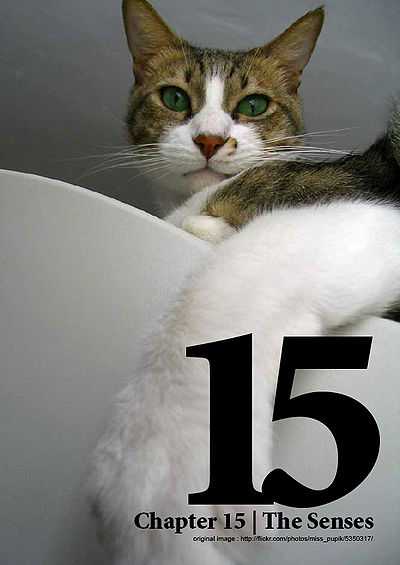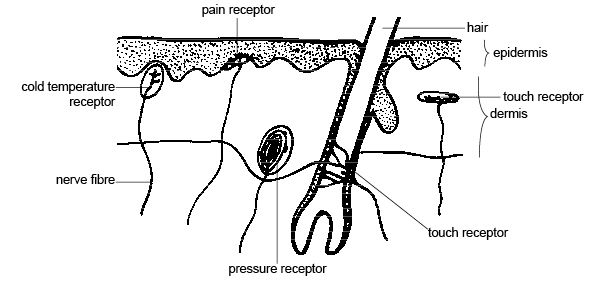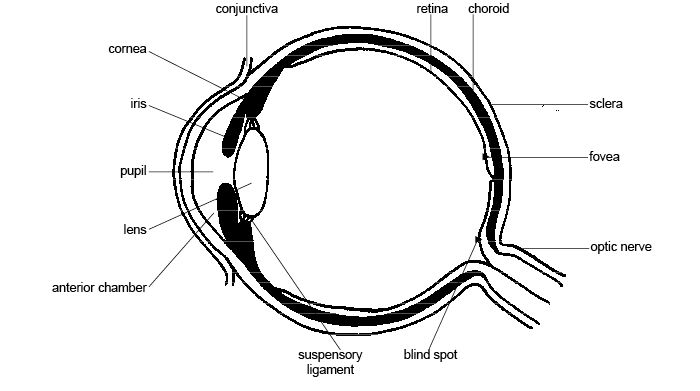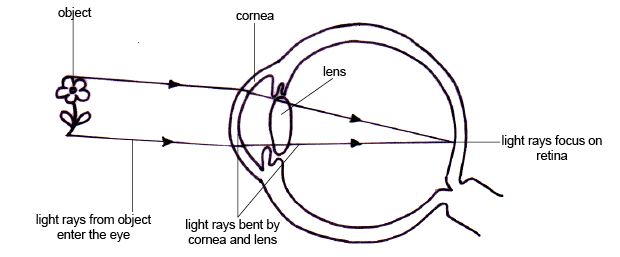Anatomy and Physiology of Animals/The Senses

Objectives
[edit | edit source]After completing this section, you should know:
- that the general senses of touch, pressure, pain etc. are situated in the dermis of the skin and in the body
- that the special senses include those of smell, taste, sight, hearing, and balance
- the main structures of the eye and their functions
- the route taken by light through the eye to the retina
- the role of the rods and cones in the retina
- the advantages of binocular vision
- the main structures of the ear and their functions
- the route taken by sound waves through the ear to the cochlea
- the role of the vestibular organ (semicircular canals and otolith organ) in maintaining balance and posture
The sense organs
[edit | edit source]Sense organs allow animals to sense changes in the environment around them and in their bodies so that they can respond appropriately. They enable animals to avoid hostile environments, sense the presence of predators and find food.
Animals can sense a wide range of stimuli that includes, touch, pressure, pain, temperature, chemicals, light, sound, movement and position of the body. Some animals can sense electric and magnetic fields. All sense organs respond to stimuli by producing nerve impulses that travel to the brain via a sensory nerve. The impulses are then processed and interpreted in the brain as pain, sight, sound, taste etc.
The senses are often divided into two groups:
- 1. The general senses of touch, pressure, pain and temperature that are distributed fairly evenly through the skin. Some are found in muscles and within joints.
- 2. The special senses which include the senses of smell, taste, sight, hearing and balance. The special sense organs may be quite complex in structure.
Touch And Pressure
[edit | edit source]Within the dermis of the skin are numerous modified nerve endings that are sensitive to touch and pressure. The roots of hairs may also be well supplied with sensory receptors that inform the animal contact with an object (see diagram 15.1). Whiskers are specially modified hairs.
Pain
[edit | edit source]Receptors that sense pain are found in almost every tissue of the body. They tell the animal that tissues are dangerously hot, cold, compressed or stretched or that there is not enough blood flowing in them. The animal may then be able to respond and protect itself from further damage
Diagram 15.1 - The general senses in the skin
Temperature
[edit | edit source]Nerve endings in the skin respond to hot and cold stimuli (See diagram 15.1).
Awareness Of Limb Position
[edit | edit source]There are sense organs in the muscles, tendons and joints that send continuous impulses to the brain that tell it where each limb is. This information allows the animal to place its limbs accurately and know their exact position without having to watch them.
Smell
[edit | edit source]Animals use the sense of smell to locate food, mark their territory, identify their own offspring and the presence and sexual condition of a potential mate. The organ of smell (olfactory organ) is located in the nose and responds to chemicals in the air. It consists of modified nerve cells that have several tiny hairs on the surface. These emerge from the epithelium on the roof of the nose cavity into the mucus that lines it. As the animal breathes, chemicals in the air dissolve in the mucus. When the sense cell responds to a particular molecule, it fires an impulse that travels along the olfactory nerve to the brain where it is interpreted as an odour (see diagram 15.2).
Diagram 15.2 - The olfactory organ - the sense of smell
The olfactory sense in humans is rudimentary compared to that of many animals. Carnivores that hunt have a very highly developed sensitivity to scents. For example a polar bear can smell out a dead seal 20 km away and a bloodhound can distinguish between the trails of different people although it may sometimes be confused by the criss-crossing trail of identical twins.
Snakes and lizards detect odours by means of Jacobson’s organ. This is situated on the roof of the mouth and consists of pits containing sensory cells. When snakes flick out their forked tongues they are smelling the air by carrying the molecules in it to the Jacobson’s organ.
Taste
[edit | edit source]The sense of taste allows animals to detect and identify dissolved chemicals. In reptiles, birds, and mammals the taste receptors (taste buds) are found mainly to the upper surface of the tongue. They consist of pits containing sensory cells arranged rather like the segments of an orange (see diagram 15.3). Each receptor cell has a tiny “hair” that projects into the saliva to sense the chemicals dissolved in it.
Diagram 15.3. Taste buds on the tongue
The sense of taste is quite restricted. Humans can only distinguish four different tastes (sweet, sour, bitter and salt) and what we normally think of as taste is mainly the sense of smell. Food is quite tasteless when the nose is blocked and cats often refuse to eat when this happens.
Sight
[edit | edit source]The eyes are the organs of sight. They consist of spherical eyeballs situated in deep depressions in the skull called the orbits. They are attached to the wall of the orbit by six muscles, which move the eyeball. Upper and lower eyelids cover the eyes during sleep and protect them from foreign objects or too much light, and spread the tears over their surface.
The nictitating membrane or haw is a transparent sheet that moves sideways across the eye from the inner corner, cleansing and moistening the cornea without shutting out the light. It is found in birds, crocodiles, frogs and fish as well as marsupials like the kangaroo. It is rare in mammals but can be seen in cats and dogs by gently opening the eye when it is asleep. Eyelashes also protect the eyes from the sun and foreign objects.
Structure of the Eye
[edit | edit source]Lining the eyelids and covering the front of the eyeball is a thin epithelium called the conjunctiva. Conjunctivitis is inflammation of this membrane. Tear glands that open just under the top eyelid secrete a salty solution that keeps the exposed part of the eye moist, washes away dust and contains an enzyme that destroys bacteria.
The wall of the eyeball is composed of three layers (see diagram 15.4). From the outside these are the sclera, the choroid and the retina.
Diagram 15.4 - The structure of the eye
The sclera is a tough fibrous layer that protects the eyeball and gives it rigidity. At the front of the eye the sclera is visible as the “white” of the eye, which is modified as the transparent cornea through which the light rays have to pass to enter the eye. The cornea helps focus light that enters the eye.
The choroid lies beneath the sclera. It contains a network of blood vessels that supply the eye with oxygen and nutrients. Its inner surface is highly pigmented and absorbs stray light rays. In nocturnal animals like the cat and possum this highly pigmented layer reflects light as a means of conserving light. This is what makes them shine when caught in car headlights.
At the front of the eye the choroid becomes the iris. This is the coloured part of the eye that controls the amount of light entering the pupil of the eye. In dim light the pupil is wide open so as much light as possible enters while in bright light the pupils contract to protect the retina from damage by excess light.
The pupil in most animals is circular but in many nocturnal animals it is a slit that can close completely. This helps protect the extra-sensitive light sensing tissues of animals like the cat and possum from bright sunlight.
The inner layer lining the inside of the eye is the retina. This contains the light sensing cells called rods and cones (see diagram 15.5).
The rod cells are long and fat and are sensitive to dim light but cannot detect colour. They contain large amounts of a pigment that changes when exposed to light. This pigment comes from vitamin A found in carrots etc. A deficiency of this vitamin causes night blindness. So your mother was right when she told you to eat your carrots as they would help you see in the dark!
The cone cells provide colour vision and allow animals to see details. Most are found in the centre of the retina and they are most densely concentrated in a small area called the fovea. This is the area of sharpest vision, where the words you are reading at this moment are focussed on your retina.
Diagram 15.5 - A rod and cone from the retina
The nerve fibres from the cells of the retina join and leave the eye via the optic nerve. There are no rods or cones here and it is a blind spot. The optic nerve passes through the back of the orbit and enters the brain.
The lens is situated just behind the pupil and the iris. It is a crystalline structure with no blood vessels and is held in position by a ligament. This is attached to a muscle, which changes the shape of the lens so both near and distant objects can be focussed by the eye. This ability to change the focus of the lens is called accommodation. In many mammals the muscles that bring about accommodation are poorly developed, Rats, cows and dogs, for example, are thought to be unable to focus clearly on near objects.
In old age and certain diseases the lens may become cloudy resulting in blurred vision. This is called a cataract. Within the eyeball are two cavities, the anterior and posterior chambers, separated by the lens. They contain fluids, the aqueous and vitreous humours respectively, that maintain the shape of the eyeball and help press the retina firmly against the choroid so clear images are seen.
How The Eye Sees
[edit | edit source]Eyes work quite like a camera. Light rays from an object enter the eye and are focused on the retina (the “film”) at the back of the eye. The cornea, the lens and the fluid within the eye all help to focus the light. They do this by bending the light rays so that light from the object falls on the retina. This bending of light is called refraction. The light stimulates the light sensitive cells of the retina and nerve impulses are produced that pass down the optic nerve to the brain (see diagram 15.6).
Diagram 15.6 - How the light travels from the object to the retina of the eye
Colour Vision In Animals
[edit | edit source]As mentioned before, the retina has two different kinds of cells that are stimulated by light - 'rods' and 'cones'. In humans and higher primates like baboons and gorillas the rods function in dim light and do not perceive colour, while the cones are stimulated by bright light and perceive details and colour.
Other mammals have very few cones in their retinas and it is believed that they see no or only a limited range of colour. It is, of course, difficult to find out exactly what animals do see. It is thought that deer, rats, and rabbits and nocturnal animals like the cat are colour-blind, and dogs probably see green and blue. Some fish and most birds seem to have better colour vision than humans and they use colour, often very vivid ones, for recognizing each other as well as for courtship and protection.
Binocular Vision
[edit | edit source]Animals like cats that hunt have eyes placed on the front of the head in such a way that both eyes see the same wide area but from slightly different angles (see diagram 15.7). This is called binocularvision. Its main advantage is that it enables the animals to estimate the distance to the prey so they can chase it and pounce accurately.
Diagram 15.7 - Well developed binocular vision in predator animals like the cat
In contrast plant-eating prey animals like the rabbit and deer need to have a wide panoramic view so they can see predators approaching. They therefore have eyes placed on the side of the head, each with its own field of vision (see diagram 15.8). They have only a very small area of binocular vision in front of the head but are extremely sensitive to movement.
Diagram 15.8 - Panoramic monocular vision in prey animals like the rabbit
Hearing
[edit | edit source]Animals use the sense of hearing for many different purposes. It is used to sense danger and enemies, to detect prey, to identify prospective mates and to communicate within social groups. Some animals (e.g. most bats and dolphins) use sound to “see” by echolocation. By sending out a cry and interpreting the echo, they sense obstacles or potential prey.
Structure of the Ear
[edit | edit source]Most of the ear, the organ of hearing, is hidden from view within the bony skull. It consists of three main regions: the outer ear, the middle ear and the inner ear (see diagram 15.9).
Diagram 15.9 - The ear
The outer ear consists of an ear canal leading inwards to a thin membrane known as the eardrumor tympanic membrane that stretches across the canal. Many animals have an external ear flap or pinna to collect and funnel the sound into the ear canal. The pinnae (plural of pinna) usually face forwards on the head but many animals can swivel them towards the source of the sound.
In dogs the ear canal is long and bent and often traps wax or provides an ideal habitat for mites, yeast and bacteria.
The middle ear consists of a cavity in the skull that is connected to the pharynx (throat) by a long narrow tube called the Eustachian tube. This links the middle ear to the outside air so that the air pressure on both sides of the eardrum can be kept the same. Everyone knows the uncomfortable feeling (and affected hearing) that occurs when you drive down a steep hill and the unequal air pressures on the two sides of the eardrum cause it to distort. The discomfort is relieved when you swallow because the Eustachian tubes open and the pressure on either side equalises.
Within the cavity of the middle ear are three of the smallest bones in the body, the auditory ossicles. They are known as the hammer, the anvil and the stirrup because of their resemblance to the shape of these objects. These tiny bones articulate (move against) each other and transfer the vibrations of the eardrum to the membrane covering the opening to the inner ear.
The inner ear is a complicated series of fluid-filled tubes imbedded in the bone of the skull. It consists of two main parts. These are the cochlea where sound waves are converted to nerve impulses and the vestibular organ that is associated with the sense of balance and has no role in hearing (see later).
The cochlea looks rather like a coiled up snail shell. Within it there are specialised cells with fine hairs on their surface that respond to the movement of the fluid within the cochlea by producing nervous impulses that travel to the brain along the auditory nerve.
How The Ear Hears
[edit | edit source]Sound waves can be thought of as vibrations in the air. They are collected by the ear pinna and pass down the ear canal where they cause the eardrum to vibrate. (An interesting fact is that when you are listening to someone speaking your eardrum vibrates at exactly the same rate as the vocal cords of the person speaking to you).
The vibration of the eardrum sets the three tiny bones in the middle ear moving against each other so that the vibration is transferred to the membrane covering the opening to the inner ear. As well as transferring the vibration, the tiny ear bones also amplify it. The three tiny bones are called the stirrup, anvil, and hammer. They were called such of their form. In the human ear this amplification is about 20 times while in desert-dwelling animals like the kangaroo rat it is 100 times. This acute hearing warns them of the approach of predators like owls and snakes, even in the dark.
The vibration causes waves in the fluid in the inner ear that pass down the cochlea. These waves stimulate the tiny hair cells to produce nerve impulses that travel via the auditory nerve to the cerebral cortex of the brain where they are interpreted as sound.
To summarise: The route sound waves take as they pass through the ear is: External ear | tympanic membrane | ear ossicles | inner ear |cochlear | hair cells
The hair cells generate a nerve impulse that travels down the auditory nerve to the brain.
Remember that sound waves do not pass along the Eustachian tube. Its function is to equalise the air pressure on either side of the tympanic membrane.
Balance
[edit | edit source]The vestibular organ of the inner ear helps an animal maintain its posture and keep balanced by monitoring the movement and position of the head. It consists of two structures - the semicircular canals and the otolith organs.
The semicircular canals (see diagram 15.10) respond to movement of the body. They tell an animal whether it is moving up or down, left or right. They consist of three canals set in three different planes at right angles to each other so that movement in any direction can be registered. The canals contain fluid and sense cells with fine hairs that project into the fluid. When the head moves the fluid swirls in the canals and stimulates the hair cells. These send nerve impulses along the vestibular nerve to the cerebellum.
Note that the semicircular canals register acceleration and deceleration as well as changes in direction but do not respond to movement that is at a constant speed.
The otolith organs are sometimes known as gravity receptors. They tell you if your head is tilted or if you are standing on your head. They consist of bulges at the base of the semi circular canals that contain hair cells that are covered by a mass of jelly containing tiny pieces of chalk called otoliths (see diagram 15.10). When the head is tilted, or moved suddenly, the otoliths pull on the hair cells, which produce a nerve impulse. This travels down the vestibular nerve to the cerebellum. By coordinating the nerve impulses from the semicircular canals and otolith organs the cerebellum helps the animal keep its balance.
Diagram 15.10 - Otolith Organs
Summary
[edit | edit source]- Receptors for touch, pressure, pain and temperature are found in the skin. Receptors in the muscles, tendons and joints inform the brain of limb position.
- The olfactory organ in the nose responds to chemicals in the air i.e. smell.
- Taste buds on the tongue respond to a limited range of chemicals dissolved in saliva.
- The eyes are the organs of sight. Spherical eyeballs situated in orbits in the skull have walls composed of 3 layers.
- The tough outer sclera protects and holds the shape of the eyeball. At the front it becomes visible as the white of the eye and the transparent cornea that allows light to enter the eye.
- The middle layer is the choroid. In most animals it absorbs stray light rays but in nocturnal animal it is reflective to conserve light. At the front of the eye it becomes the iris with muscles to control the size of the pupil and hence the amount of light entering the eye.
- The inner layer is the retina containing the light receptor cells: the rods for black and white vision in dim light and the cones for colour and detailed vision. Nerve impulses generated by these cells leave the eye for the brain via the optic nerve.
- The lens (with the cornea) helps focus the light rays on the retina. Muscles alter the shape of the lens to allow near and far objects to be focussed.
- Aqueous humour fills the space immediately behind the cornea and keeps it in shape and vitreous humour, a transparent jelly-like substance, fills the space behind the lens allowing light rays to pass through to the retina.
- The ear is the organ of hearing and balance.
- The external pinna helps funnel sound waves into the ear and locate the direction of the sound. The sound waves travel down the external ear canal to the eardrum or tympanic membrane causing it to vibrate. This vibration is transferred to the auditory ossicles of the middle ear which themselves transfer it to the inner ear. Here receptors in the cochlea respond by generating nerve impulses that travel to the brain via the auditory (acoustic) nerve.
- The Eustachian tube connects the middle ear with the pharynx to equalise air pressure on either side of the tympanic membrane.
- The vestibular organ of the inner ear is concerned with maintaining balance and posture. It consists of the semicircular canals and the otolith organs.
Worksheet
[edit | edit source]Test Yourself
[edit | edit source]1. Where are the organs that sense pain, pressure and temperature found?
2. Which sense organ responds to chemicals in the air?
3. Match the words in the list below with the following descriptions.
- optic nerve | choroid | cornea | aqueous humor | retina | cones | iris | vitreous humour | sclera | lens
- a) Focuses light rays on the retina.
- b) Respond to colour and detail.
- c) Outer coat of the eyeball.
- d) Carries nerve impulses from the retina to the brain.
- e) The chamber behind the lens is filled with this.
- f) This layer of the eyeball reflects light in nocturnal animals like the cat.
- g) This is the transparent window at the front of the eye.
- h) This constricts in bright light to reduce the amount of light entering the eye.
- i) The light rays are focused on here by the lens and cornea.
- j) The chamber in front of the lens is filled with this.
4. Add the following labels to the diagram of the ear below.
- pinna | Eustachian tube | cochlea | tympanic membrane | external ear canal | ear ossicles | semicircular canals
5. What is the role of the Eustachian tube?
6. What do the ear ossicles do?
7. What is the role of the semicircular canals?
Websites
[edit | edit source]- http://en.wikipedia.org/wiki/Sense Wikipedia. The old faithful. You can explore here to your hearts desire. Try ‘eye’, ‘ear’, ‘taste’ etc. but also ‘equilibrioception’, and ‘echolocation’.
- http://www.bbc.co.uk/science/humanbody/body/factfiles/smell/smell_ani_f5.swf BBC Science and Nature. BBC animation of (human) olfactory organ and smelling.
- http://www.bbc.co.uk/science/humanbody/body/factfiles/taste/taste_ani_f5.swf BBC Science. BBC animation of (human) taste buds and tasting.
- http://web.archive.org/web/20071121213719/http://www.bishopstopford.com/faculties/science/arthur/Eye%20Drag%20%26%20Drop.swf Eye Diagram. A diagram of the eye to label and test your knowledge.
- http://www.bbc.co.uk/science/humanbody/body/factfiles/hearing/hearing_animation.shtml BBC on Hearing. BBC animation of hearing. Well worth looking at.
- http://www.wisc-online.com/objects/index_tj.asp?objid=AP1502 Ear Animation. Another great animation of the ear and hearing.
- http://www.bbc.co.uk/science/humanbody/body/factfiles/balance/balance_ani_f5.swf BBC Balance Animation. An animation of the action of the otolith organ (called macula in this animation)











